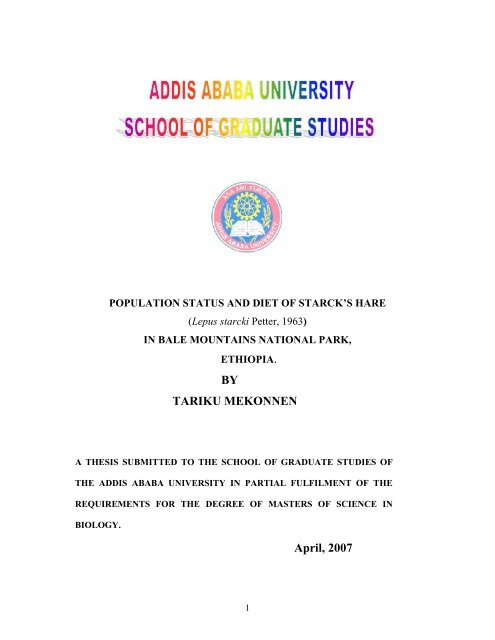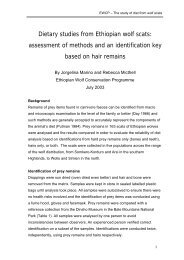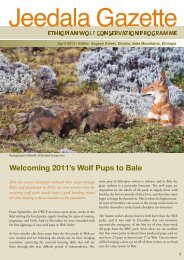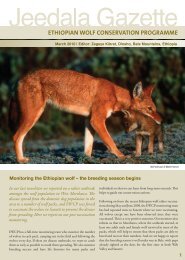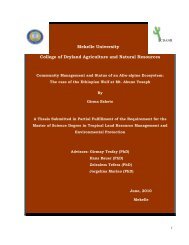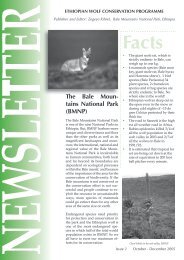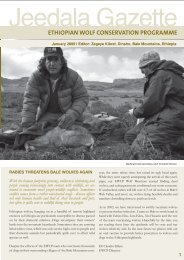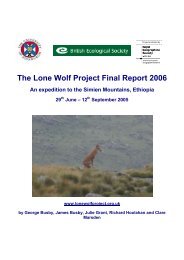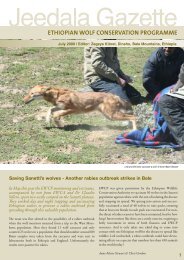tariku mekonnen - Ethiopian Wolf Conservation Programme
tariku mekonnen - Ethiopian Wolf Conservation Programme
tariku mekonnen - Ethiopian Wolf Conservation Programme
You also want an ePaper? Increase the reach of your titles
YUMPU automatically turns print PDFs into web optimized ePapers that Google loves.
POPULATION STATUS AND DIET OF STARCK’S HARE(Lepus starcki Petter, 1963)IN BALE MOUNTAINS NATIONAL PARK,ETHIOPIA.BYTARIKU MEKONNENA THESIS SUBMITTED TO THE SCHOOL OF GRADUATE STUDIES OFTHE ADDIS ABABA UNIVERSITY IN PARTIAL FULFILMENT OF THEREQUIREMENTS FOR THE DEGREE OF MASTERS OF SCIENCE INBIOLOGY.April, 20071
1. INTRODUCTION AND LITERATURE REVIEW1.1 Introduction1.1.1 Background of the studyThe geographical location and physical features of Ethiopia have resulted in thediversification of wildlife (Yalden, 1983; Shibiru Tedla, 1995). Thus, Ethiopia possesses aunique and characteristic fauna with a high level of endemism (Yalden 1988; Hillman, 1993a,b).In Ethiopia, 284 mammalian species have been recorded, of which 31(11%) are endemic(Hillman, 1993a; Leykun Abunie, 2000). A total of 861 bird species are also known to occurin the country, of which 16 are endemic (Hillman, 1993a; Yalden and Largen, 1992).However, due to human pressure on natural habitats and related factors, many of these wildanimals are at present confined to the limited protected areas.Ethiopia is distinguished from all other African countries by its large area of highlands. Over80% of African highland areas above 3000 m altitude are located in Ethiopia (Yalden, 1983;Sillero-Zubiri, 1994). The Rift Valley separates the highlands and mountain areas of thecountry into Northwest and Southeast (Uhlig, 1988). Although the species diversity in thesehighlands is less than the lowland, there is a high number of endemic mammalian and avianspecies (Yalden and Largen, 1992; Kingdon, 1997; Stephens, 1997).The Bale Mountains National Park (BMNP) is situated in the southeastern Ethiopia, along theeastern edge of the Rift Valley. It provides broad range of habitats from 1500 to 4377 m asl(Tullu Deemtu) (Hillman, 1986). BMNP was established in 1969 following therecommendation made in 1964/66 by Brown (Sillero-Zubiri, 1994). The Park was establishedprimarily for the conservation of the <strong>Ethiopian</strong> wolf and Mountain nyala and also part of thelargest tract of the afroalpine habitats in Africa (Hillman, 1993b; Befekadu Refera andAfework Bekele, 2004). It also conserves a major water catchments area important to bothEthiopia and Somalia (Hillman, 1988).1.1.2 Statement of the problem and JustificationFor effective research and management of wildlife species, a reliable estimate of populationnumber and feeding habits of mammals are in the center of population biology and ecology(Putman, 1984; Matrai et al., 1998). Starck’s hare (Lepus starcki Petter, 1963) is one of the2
endemic mammals of Ethiopia (Yalden and Largen, 1992; Kingdon, 1997) and potentially avery important part of the ecosystem. Sillero-Zubiri (1994) made detailed study of the feedingecology of the <strong>Ethiopian</strong> wolf in the BMNP. The diet of <strong>Ethiopian</strong> wolf in this area isprimarily rodents followed by Starck’s hare and other small ungulates. Morris and Malcolm(1977) and Malcolm (1997) stated Starck’s hare as the important prey of the <strong>Ethiopian</strong> wolf.Although it is endemic to the country and an important part of the diet of the endangered andendemic <strong>Ethiopian</strong> wolf, detailed study about this endemic species is lacking. These pointshave led to the formulation of the objective of the present study.The present study provides preliminary information on the current population status, diet andother related aspects of Starck’s hare in BMNP. This information will form the base-line datarelevant to further studies and conservation of the species. In addition, the study has criticalvalue in the conservation of the <strong>Ethiopian</strong> wolf since this animal is part of the food chain.1.2 Literature reviewAlthough Starck’s hares are common and widespread throughout the BMNP, no specificstudies on the species have been carried out and literature available on the species is limited.However, limited information on the ecology, density, and taxonomy of the species in BMNPis referenced in Hillman (1986), Azzaroli-Puccetti (1987), Hoffman (1993), Sillero-Zubiri(1994), Azzaroli-Puccetti et al. (1996), Kingdon (1997) and Sillero-Zubiri and Macdonald(1997).Lepus starcki (‘Hillensa’ in Afan Oromo, ‘Tinchel’ in Amharic, Starck’s hare or <strong>Ethiopian</strong>highland hare in English) have a pale brown color (tawny) at their back, nape, chest and legs.The tail is white with black stripe. Ears have a prominent black tip. They have grooves on thefront of the upper incisors that lack cement and large mesoptrygoid space in the palatal regionof the skull (Yalden and Largen, 1992). The mean measurements of Starck’s hare were: HB42-60 cm, T 7-12 cm, W 2-3.5 kg (Kingdon, 1997).1.2.1 Taxonomy and distributionStarck’s hare (Plate 1) is classified in the genus Lepus, Family Leporidae, Order Lagomorpha.The key characteristic of lagomorphs, to be classified in the separate order is the presence ofthe second incisor behind the first large upper incisor (Burton, 1984; Nowak, 1999).3
The family Leporidae contains 11 genera and 60 species (Robinson and Matthee, 2005). Thegenus Lepus contains more than 29 species (Nowak, 1999; Vaughan et al. 1999). Theimportant specific characteristics of hares occur in the morphology and anatomy of the teethand skull. Thus, it is too difficult to identify the different species of hares looking at thephysical appearance only, even in the hand (Young, 1975; Burton, 1984). Most hares inAfrica are considered as Lepus capensis Linnaeus, 1758 (Robinson and Matthee, 2005). Thetaxonomy of the genus Lepus in Africa is very confusing and its classification is still debated(Wilson and Reeder, 1993; Robinson and Matthee, 2005). Although many hypotheses havebeen proposed to clarify the specific species of hares, taxonomists did not reach consensus.In 1963, Petter originally described Starck’s hare as a race of L. capensis, and an endemicmammal to Ethiopia (Yalden and Largen, 1992). However, Azzaroli-Puccetti (1987) arguedthat L. starcki should be regarded as an isolated southern race of European brown hare (Lepuseuropaeus Pallas, 1778). Because of its importance for hunting, the European brown hare waswidely distributed to many countries outside its original range (Angerman, 1983; Nowak,1999). However, initially Lepus europaeus, itself, was regarded as a race of L. capensis, but atpresent L. capensis and L. europaeus are grouped under different species (Yalden and Largen,1992).In Ethiopia, Azzaroli-Puccetti, (1987) identified five species of hares: Lepus crawshayi deWinton, 1899, Lepus fagani Thomas, 1903, Lepus habessinicus Hemprich and Ehrenberg,1832, L. starcki and L. capensis. Though L. habessinicus and L. crawshayi have beenrecognized as distinct species, Hoffman (1993) has included them in L. capensis and Lepusvictoriae Thomas, 1893, respectively.Kingdon (1997) grouped the African true hares under Cape hare (L. capensis), Scrub hare(Lepus saxatils F. Cuvier, 1823) and Starck’s hare (L. starcki). In the above classification,unlike Hoffman (1993), L. fagani and L. victoriae are grouped as sub-species of L. saxatilis.Among the mammals, the genus Lepus is one of the most widespread species occurring in thePalaearctic and the Nearctic, including Ethiopia (Azzaroli-Puccetti et al., 1996). Differentspecies of hares have been distributed in different parts of Africa (Table 1).4
Table 1. The different species of Lepus and their distribution in Africa.Species Distribution Common nameLepus capensis The most wide spread Cape hareL. saxatilis -Cape provinceScrub hare-South NamibiaL. starcki Highlands of Ethiopia Starck’s hare(<strong>Ethiopian</strong> highland hare)Source: Kingdon, 1997Hares are confined to open and even dryland habitats. Unlike rabbits, they never excavateburrow (Kingdon, 1971). They mainly live in grass nests and sometimes shelter in caves androcks (Kingdon, 1997). In Africa, the true hares are represented in open grass areas.Starck’s hares are mainly found in afroalpine parts of the BMNP including Tullu Deemtu butalso seen at low density in heather moorland and forest as well as northern woodlands of thePark (Hillman, 1986). Yalden and Largen (1992) stated that Starck’s hares are quite abundanton the moorlands of Bale Mountains. At the same time, they also occur on both sides of RiftValley at altitude of 2140-4000 m asl in both grassland and afroalpine moorland. Sillero-Zubiri (1994) stated Starck’s hares were particularly abundant on Sanetti Plateau and less inericaceous heather and montane grassland. He also estimated the density 0.3, 0.2, 0.17, per haat Sanetti Plateau, Tullu Deemtu and Web Valley, respectively.The two species of hares in Ethiopia, L. starcki and L. habessinicus are adapted to quitedifferent environments. L. habessinicus occurs at lower altitude and arid areas of easternEthiopia. However, Lepus starcki are confined to central highlands of the country (Fig. 1).1.2.2 EcologyAs there is little information on the ecology of Starck’s hare in BMNP, understanding thegeneral ecology of hares is important for this study. Hares are herbivores and eat widevarieties of plants including grass, herbs, and barks of plants (Stanbury, 1972). However, theyoften show preference to certain species of vegetation (de Vos, 1964; Hamolka, 1987). Thesepreferences vary greatly between regions and are dependent on the local plant communities(Hodges, 2000; Strevens and Rockford, 2002). The front teeth of hares continue to grow aslong as the animal lives and are used to cut plants (Nowak, 1999; Vaughan et al., 1999).They have the dental formula 2/1 0/0 3/2 3/3 (Burton, 1984).5
.Hares circulate food twice (as do rabbits) and produce two different types of faeces. One typeis soft and rich in vitamins and re-eaten (eaten directly from the anus) while the other type isthe hard dry dung pellets normally observed in their habitat (Burton, 1984; Nowak, 1999).Hillman (1986) and Kingdon (1997) mentioned the diets of Starck’s hares on BMNP to feedupon the common moorland grasses such as Agrostis, Eleusine, Festuca, Pennisetum andPoa.The reproduction of Starck’s hare has not been yet studied. However, for the other species ofAfrican and European hares, the pattern of reproduction is well known. Kingdon (1997) statedthat African hares have a continuous reproductive season in a year. There is no set breedingseason in East Africa and gestation period is only six weeks. A female hare bears six litters ayear normally with one or two young per litter (Dodds, 1965; Young, 1975; Vaughan et al.,1999). The young is born furred with eyes open and active compared to rabbits which areborn naked and with their eyes closed (Burton, 1984; Nowak, 1999). The female hare spendslittle time taking care of her young (McCullough, 1989). The young are left in the forms(place where they stay during inactive time) and the mother only suckles them for a briefperiod of about five minutes every 24 hours (McFarland, 1985; Corbet and Hill, 1991;Vaughan et al., 1999). Yalden and Largen (1992) obtained two female Starck’s hares shot onSanetti Plateau in 1971; of which one was pregnant with one embryo.Except during mating season, most species of hares are solitary (Flux, 1964; Cloudsley-Thompson, 1969; Kingdon, 1971; McFarland, 1985; Caughley and Sinclair, 1994). However,they usually live with others within the home range (Vaughan et al., 1999). The home rangevaries in size depending upon the type of habitat that includes forms, terrain, direction oflight, and vegetation (McCullough, 1989; Estes, 1991).To protect themselves from enemies they rely on camouflage, active sense organ (smell andsight) and speed. They can run at the speed of 70 km/hr (Kingdon, 1971). If they are chased,first, they run in straight line then they change to zigzag pattern. They take sand baths to keeptheir fur clean and groom themselves several times within a day.The population of hares can be influenced by weather effects, food supply, predation, parasiteand disease (Angerbjorn, 1983). They are the main food source of many animals, such as,<strong>Ethiopian</strong> wolves, foxes, mountain lions, wild cats, hawks and coyotes (Kingdon, 1971;Burton, 1984; Hillman, 1986; McCullough, 1989; Nowak, 1999; Vaughan et al., 1999).6
1.2.3 Significance and ThreatsHares are important economically and aesthetically for humans (Burton, 1984; Nowak, 1999).They provide sport hunting, food and fur. Hares also form an important link in ecologicalfood chains. Many predators rely on the abundance of hares for their diet. One example of thisphenomenon is the linkage of <strong>Ethiopian</strong> wolf and Starck’s hares in the Bale Mountains(Morris and Malcolm, 1977; Sillero-Zubirii, 1994; Sillero-Zubiri and Macdonald, 1997;Marino, 2003).Human induced disturbance is the major threat in the BMNP (Hillman, 1986). In the higherparts of the Bale Mountains, there were very little settlements in the past. In 1984, permanentsettlement in the Park was estimated at 2,500 (Hillman, 1986; Stephens, 1997; Marino, 2003).However, because of increased human pressure and expansion of agriculture on the lowlandhabitats of the Park, the human settlement has been increasing (Hillman, 1986; Gottelli andSillero-Zubiri, 1990; Miehe and Miehe, 1994; Marino, 2002). The settlement areas aredivided into permanent and nomadic (temporary). In addition to the settlements, for thepurpose of utilizing mineral springs (Horas), large number of people enters the Park with theirlivestock and stay around the horas for about a month (Hillman, 1986; Kemp-McCarthy,1990). This continued expansion leads to alteration of landscapes with irreversible loss ofbiodiversity.Since the living condition during the rainy season is difficult on the afroalpine part of thepark, the number of permanent settlements is relatively few (Miehe and Miehe, 1994).However, permanent settlements have been observed at the edge of southern side of TulluDeemtu and around Sanetti area during the study period.Bale is known for its cattle population. The most common large herbivores in the mountainmassifs are domestic cattle (Stephens, 1997; Stephens et al., 2002). Hillman (1986) estimatedthe total number of livestock inside the Park to be 10,500. However, it has been increasingsince the establishment of the Park. Sillero-Zubiri (1994) estimated the number of cattle in theWeb Valley to be 43/km 2 , counting 3,003 cattle in 70 km 2 . In 1997, the number of livestockon Sanetti Plateau increased (Stephens, 1997). The number of livestock varied from season toseason with the highest during late wet season in Web Valley. As all the livestock areherbivores and feed mainly on grasses, they compete with native herbivores of the afroalpinehabitat, which may reduce the prey base of wolves.7
1.2.4 Diet and density estimation techniquesIdentification of diet of herbivores is more complex than carnivore diet (Putman, 1984). Thusa reliable method for measuring the species composition and proportion of food in the diet ofherbivores is required (Fitzgerald and Waddington, 1979). Several methods have been used toidentify hare diets including stomach content analysis, faecal analysis, direct observation,vegetation monitoring to find vegetation twigs (de Vos, 1984; Sinclair and Smith, 1984;Zimmer, 2004). Currently, DNA analysis method has been developed to enable identificationof food plant species even from the residue of faeces (Matsuki, 2004). However, all thetechniques have drawbacks (Fitzgerald and Waddington, 1979; Bart et al., 1998). Directlyobserving animals when they feed does not give accurate result, in habitats of high diversityof plant species, to species level (Wallamo et al., 1973). Stomach content analysis is notpractical on live animal and the result may be unreliable in that some species of plants areeasily digested and involves a portion of the meal (Westoby et al., 1976). Faecal analysis ispotentially one of the best methods but identifying the plant fragments seen on themicroscope is difficult (Fitzgerald and Waddington, 1979).Density of hares can be estimated through faecal count, line transect (distance samplingmethod) and DNA analysis. Faecal pellet counts can be used to asses the numbers of harespresent in the area. To use this technique the daily production of pellets per hare, the averagedecay rate and the number of pellets (all pellets) in the area should be known (Parkes, 1999).Density estimation from the use of line transects is practical, efficient, and inexpensive formany population and it can give estimates of absolute hare density (Gates et al., 1968;Anderson et al., 1979; Buckland et al., 1993; Bart et al., 1998). The method assumes that, allanimals on the transect (at the zero distance from the line) are counted and the visibilitydecreases with distance from the transect. This decline in visibility is measured empiricallyfrom data, and an estimate of density is calculated.Through individual identification by using DNA of intestinal cells attached to faeces, it ispossible to identify individual hares (Matsuki, 2004). This method is much more reliablecompared with other methods, and based on faeces specimen number.2. OBJECTIVES OF THE STUDY2.1 General objective8
The over all objective of the present study is to determine the diet and current populationstatus of Starck’s hare in the afroalpine part of BMNP.2.2 Specific objectivesThese were: To estimate the density of Starck’s hare in the afroalpinepart of BMNP. To identify the diet of Starck’s hare in Sanetti Plateau. To estimate the forage availability in the study area.. To suggest measures for conservation of the species.3. DESCRIPTION OF THE STUDY AREA3.1 LocationThe Bale Mountains National Park (BMNP) is located southeast of the Rift Valley about 400km by road from Addis Ababa, between 6 0 29` and 7 0 10` North, and 39 0 28` and 39 0 58` East.It covers an area of 2200 km 2 , with an altitudinal range from 1500 - 4377 m asl (Hillman,1986).The typical afroalpine habitats in BMNP, Sanetti Plateau (3800-4050 m), Web Valley (3450-3550 m) and Tullu Deemtu (4000-4377 m asl) formed the main study area (Fig. 2). TulluDeemtu (at 4,377 m asl) is the highest mountains in southern Ethiopia and second in thecountry (Marino, 2003). The current study was located at the base of the mountain (4000 masl).3.2 Climate and soilThe climate of the Bale Mountains varies due to the great altitudinal gradient within the Parkand the large extent of the mountain massif (Hillman, 1986). The Bale Mountains are subjectto hot days and cold nights during the dry season, and a more temperate wet season fromMarch to October (Stephens, 1997). Temperature shows altitudinal gradient within the Park9
from -3 to 24 0 C at low altitude, and from -15 to 26 0 C at higher altitude during the dry season(Hillman and Hillman, 1987; Sillero-Zubri, 1994). The rainy season is warmer, compared tothe dry season, and the temperature shows much less daily fluctuation. There is also arelatively narrower range in the diurnal temperature from 5 to 20 0 C (Hillman, 1986).Figure 2. Location of the study areaIn the Bale Mountains National Park, rains come from two different sources at various timesof the wet season; the Equatorial Westerlies and the Indian Ocean Monsoon (Miehe andMiehe, 1994). The annual rainfall ranges from 1000 to1400 mm (Daniel Gamachu, 1977).The Bale Mountains is characterized by eight months rainy season from March to October,followed by a four month dry season from November to February (Daniel Gamachu, 1977;Hillman, 1986; Sillero-Zubri, 1994). The annual rainfall increases with altitude until 3850 masl, after which it begins to decrease again (Hillman, 1986; Sillero-Zubiri, 1994). Thedistribution of rainfall is not uniform during the wet season, showing two peaks from April toMay and September to October. Storms of rain and hail sometimes give the mountain massif10
the appearance of a snow field. Hail and snow can lie on the ground for one or two days(Sillero-Zubiri, 1994).Mohr (1971) described that the Bale Massif consists of Tertiary Trappean lavas, whichcovered the Mesozoic Marine Sediments and the underlying Precambrian rock after theEocene uplifting of the <strong>Ethiopian</strong> highlands. As the upper geological strata of the BaleMountains are entirely volcanic, the soil is mainly derived from the basaltic and trachyticparent rock. It is fairly fertile silty loam of reddish brown to black color (Morton, 1976;Miehe and Miehe, 1994). The Bale Mountains show distinct signs of recent glaciations(Smeds, 1959; Morton, 1976; Hedberg, 1986).3.3 BiodiversityThe Bale Mountains provide a broad range of habitats for large varieties of animal species,many of which are endemic (Mohammed Abdi, 1987; Lisanework Nigatu and MesfinTadesse, 1989; Yalden, 1988; Hillman, 1993a, b). Yalden and Largen (1984) underlined theimportance of the Bale Mountains as a center of endemicity and reservoir of unknown geneticresources. More than 66 mammal species have been recorded, of which 17 species areendemic to the country, including the two endangered species, the <strong>Ethiopian</strong> wolf andMountain nyala. Over 280 species of birds have been recorded (Yalden, 1988).About 53% (9 of 17) endemic mammals of BMNP are rodent species (Hillman, 1986;Stephen, 1997). Of these, the giant mole rat (Tachyoryctes macrocephalus) has a particularimportance as the main food item in the diet of the <strong>Ethiopian</strong> wolf (Sillero-Zubiri and Gottelli,1995).Yalden (1983), Hillman (1986), Minasie Gashaw (1990, 1991), Miehe and Miehe (1994),Sillero-Zubiri (1994), Minasie Gashaw and Masresha Fetene (1996), Nauke (2001) andMarino (2003) have carried out studies on different aspects of the vegetation in BMNP. Thehigh rainfall in the Bale Mountains together with variation in altitude and topography resultedin diversity of the vegetation (Miehe and Miehe, 1994; Gotteli and Sillero-Zubiri, 1990). TheBMNP contains the northern grassland, the northern woodland, heather moorland, afroalpinemeadow and Harenna forest. Montane grasslands are represented by the northern GaysayValley while Harenna Forest is the woodlands and forest parts of the BMNP.11
Ethiopia has the largest afroalpine habitat in Africa, of which most occur as part of the BaleMountains (Yalden, 1983; Hedberg, 1986; Sillero-Zubiri, 1994). The afroalpine meadowcovers 31.6% of the BMNP (Hillman, 1996). It is characterized by sparse, short vegetationadapted to low rainfall and heavy frosts. Due to the extreme climatic condition, the plantspecies diversity is low, and vegetation cover decreases at higher altitude (Sillero-Zubiri,1994; Sillero-Zubiri et al., 1995; Minasie Gashaw and Masresha Fetene, 1996). The dominantvegetation in the afroalpine habitats are: Artemisia, Kniphofia, bushes of Erica andHelichrysum citrispinium (Marino, 2003).The main representative of afroalpine habitat in BMNP and one of the present study areas,Sanetti Plateau, is dominated by short tussock grasses. However, the grass and herbaceousplants are dispersed and mosses cover large proportion of the ground (Marino, 2003). TulluDeemtu was dominated by afroalpine Helichrysum heath. However, Sanetti Plateau and WebValley represent typical open grass afroalpine habitats (Sillero-Zubiri, 1994; Marino, 2003).4. MATERIALS AND METHODS4.1 MaterialsMaterials used during the study period includes: Global positioning system (GPS), binocular(both day and night vision), rangefinder, net, cameras, spring balance, dissecting kit,microscope, 70% ethanol, plastic bags, tape measure, stake flag, carnivore live trap, ruler andcompass.4.2 Methods4.2.1 Preliminary studyPreliminary survey was conducted in the area during March-April, 2006. During this survey,all relevant information about distribution, activity (diurnal or nocturnal) and active feedingtime of Starck’s hare were assessed. In addition, climatic condition, topography andvegetation type and coverage of the afroalpine part of BMNP were observed. The nightactivities of Starck’s hare were checked along the road using vehicle from Sanetti to TulluDeemtu (12 km) and on foot on the other part of the study area. After this survey, SanettiPlateau, Tullu Deemtu and Web Valley were selected for study area. The best time to studythe species was identified to be at dusk and dawn when they were more active.12
During the preliminary survey, Starck’s hares were not observed in some part of afroalpinebelt (Ericaceous habitat and most Helichrysum heath). Hence, the total afroalpine grassland(Sanetti Plateau 133 km 2 , Web Valley 120 km 2 ) and some part of Helichrysum heath (TulluDeemtu 89 km 2 ) were taken as the major study area. This was based on previous BMNPhabitat division (Hillman, 1986; Sillero-Zubiri, 1994).4.2.2 Data collection and analysisTo estimate the density, line transects (distance sampling) method was used (Ruette et al.,2003; and Sutherland, 1996). A total of 10 transects were systematically located on 40 km 2 oneach of the study area at the interval of 1 km. The length of each transect was 4 km. Transectswere conducted on foot stopping and carefully observing at approximately 50 m interval.Each time, a hare was seen, was recorded as a sighting. However, in almost all cases morethan one hare was visible and the group size was recorded. When hares were detected, thenumbers of animal seen, the perpendicular distance, bearing, position and activity at the timewere recorded (Appendix 1). The survey time was at dusk and dawn.Data for vegetation availability was obtained from 44 sample sites using line intercept method(Floyd and Anderson, 1987; Sutherland, 1996; Cummings and Smith, 2001). Samples weresystematically taken every 200 m interval from along transects randomly laid to differentdirections in the study area. Specimens were collected, pressed, dried and identified in theNational Herbarium of Addis Ababa University.In each sample site, coverage and frequency of individual plants were recorded and noted foreach species on 15 m line intercept (Appendix 2).To find the mean percentage coverage of each species (MPCSp),TCSpMPCSp = × 100LWhere, TCSp = Total cover of the speciesL= Length of lineTo find the mean percentage vegetation coverage of the site (MPCS),TCSMPCS = × 100LWhere, TCS = Total cover of the siteL = Length of line13
To evaluate the richness of plant species in the study area,RIS − 1= was used.ln( N )Where, RI = Richness IndexS = the number of species of the taxonomic group observedN = total individual of them observed.Diet analysis was carried out following the methods of Davison (1964), Putman (1984),Dingerkus and Montgomery (2001), Katona and Altbacker (2002), Clausnitzer (2003) andReichlin et al. (2005).To identify the types and proportion of plant species used by L. starcki, the combination offaecal and stomach content analysis and direct observation (on the field) was used. Freshpellets of Starck’s hare were collected from sites of different vegetation types during bothseasons. In each season, two pellets were collected from 25 independent droppings at theminimum of 200 m interval. The samples were preserved in 70% ethanol and taken to theDepartment of Biology, Addis Ababa University, for further analysis. They were washedindependently with distilled water to remove fine particles for proper identification and airdried. Two slides were prepared for each sample (mixing thoroughly) and observed undermicroscope to identify the diet (Appendix 3). All fragments found on the slides wereidentified as monocotyledon, dicotyledon, or unidentified. Relative occurrence wasdetermined by dividing the number of microscopic views in which a given species occurredby the total number of views x 100 (Uresk, 1978; Katona and Altbacker 2002; Clausnitzer,2003).For stomach content analysis, different methods of trappings were used. Fresh <strong>Ethiopian</strong> wolfkills (n=2), live trapping by carnivore live traps (n=2), and netting (n=3). A total of sevenhares were used to collect information on weight, measurements and parasite (if any) inaddition to stomach content to compare with faecal analysis. The trapping took place in themorning and late afternoon to minimize the bias because of digestion. The stomach contentanalysis followed the procedure described for faecal analysis.14
In addition to faecal and stomach content analysis, direct observation was used to identifydifferent species of grasses eaten by Starck’s hare. Different types of habitats, where usuallyhares feed were selected carefully for hide observation. Using 8 x 42 binocular, species ofplant eaten were examined for 120 hrs. The plant species on the habitat were observed, beforeand after, to see the plant eaten by looking at the bite.During the study period, in addition to the basic data for this study, all information observedabout the ecology of the species was recorded, from personal observation and discussion withthe local people.For data analysis, Distance version Beta 4.1 and SPSS version 13.1 Software were used.5. RESULTS5.1 Density estimationA total of 389 and 267 Starck’s hares were recorded during wet and dry season, respectively.The difference was statistically significant (X 2 = 22.69, df =1, P< 0.001). The highest numberwas 185 during the wet season in Sanetti Plateau and the lowest number was 61 during thedry season in Web Valley (Table 2).The mean density of Starck’s hares in the study area was estimated to be 18.35 and 13.33hares per km 2 during wet and dry seasons, respectively (Table 3). The highest density wasobtained from Sanetti during the wet season (25.40/km 2 ) and the lowest at Web Valley duringthe dry season (8.51 km 2 ).Starck’s hares density during wet and dry season is given in Figure 3. During both seasons,large numbers of hares were recorded from Sanetti Plateau. On Sanetti Plateau, there was asignificant difference in the Starck’s hare counts among transects (X 2 =129.81 df= 9, P 0.05, fig. 5a, b).15
Table 2. Number of sightings and Starck’s hares recorded from each site during the twoseasons.Study site Season Number of Number of individualssightingSanettiWet 59 185Dry 82 124Tullu DeemtuWet 52 109Dry 49 82Web ValleyWet 70 95(Kotera) Dry 48 61In total study areaWet 181 389Dry 179 267Table 3. Estimates of the density and abundance of Starck’s hares for each site.Study sites Season Density95% Confidenceinterval (CI) Abundance 95% CISanetti Wet 25.40 17.43-37.01 3400 2300-4900Dry 21.17 14.59-30.73 2800 1900-4100Tullu DeemtuWet 16.11 10.71-24.23 1400 1000-2200Dry 10.31 7.05-15.10 900 600-1300Web Valley Wet 13.54 9.28-19.74 1600 1100-2400(Kotera) Dry 8.51 5.88-12.33 1000 700-1500In total study areaWet 18.35 12.47-26.99 6300 4300-9200Dry 13.33 9.17-19.39 4600 3100-660016
Figure 3. Density of Starck’s hare in the study sites during wet and dry seasons.(S= Sanetti, TD= Tullu Deemtu, WV= Web Valley, M= Mean).Figure 4. Number of Starck’s hares recorded from each transect during wet and dry seasons inSanetti Plateau.17
a) Web Valleyb) Tullu DeemtuFigure 5. Number of Starck’s hares recorded from each transect during wet and dry seasons inTullu Deemtu and Web Valley.5.2 Forage availabilityDuring the wet season, hares had most access to different species of herbs and grasses (Table4). However, the proportion of plant species changed dramatically during the dry season. Themajor components of plant species in the study area were Festuca spp., Alchemilla abyssinica,Helichrysum spp. and Trifolium spp. Usually, Starck’s hares use Helichrysum spp. as a shelter(Plate 2). During the dry season, the plants available for feeding were wetland plants. Theseinclude Carex monostachya, Ranuculus oreophytus, Haplocarpha rueppelli and Trifolium18
acaule. Although Festuca spp. and Alchemilla spp. decreased in coverage during the dryseason, their relative abundance was high. There was a significance difference (X 2 = 24.22 df= 2, P< 0.001) in species diversity within grass, herbs and shrubs in the study area. Herbsdominate all other species (Table 4). The percentage of plant cover is relatively high duringthe wet season (65.21%) and very low (< 30%) during the dry season (Fig. 6). However,species richness was the same in herbs and grasses during both seasons (Table 5).SpeciesFamilyCoverage %Wet DryAgrostis gracilifolia C.E. Hubbard Poaceae 0.2 0.8Alchemilla abyssinica Fress. Rosaceae 11.8 4.2A. haumanii Rothm. Rosaceae 1.2 1.6A. rothii Oliv. Rosaceae 5.3 1.12Anthemis tigreensis A. Rich Asteraceae 0.72 0.53Arabis alpina L. Brassicaceae 0.21 0.11Artemisia spoerri Engl. Asteraceae 0.61 0.52Carex monostachya A. Rich Poaceae 0.3 0.43Cynoglossum lanceolatum Forsk. Boraginaceae 0.21 0.10Dianthoseris schimperi A. Rich Asteraceae 0.2 0.14Erica philippia Complex Ericaceae 0.42 0.41Euryops prostratus Nordenstam Asteraceae 0.37 00Festuca spp. Poaceae 15 6.33Haplocarpha rueppelli P. Beauv. Asteraceae 2.6 0.12Hebenstretia dentate L. Scrophulariaceae 0.2 0.17Helichrysum citrispinum Del. Asteraceae 2.6 00H. gofense. Cuf Asteraceae 8.8 5.25H. splendidum Lees. Asteraceae 5.9 1.22Koeleria capensis Nees Poaceae 0.51 0.31Lobelia rhynchopetalum Hemsl. Campanulaceae 0.2 0.23Ranuculus oreophytus Del. Ranunculaceae 0.23 0.81Rumex abyssinicus Jacq. Polygonaceae 0.3 0.63Salvia nilotica Juss. Ex. Jacq Lamiaceae 0.34 00Satureja simensis (Benth.) Brif. Lamiaceae 0.11 00Senecio schultzii Hochst Asteraceae 0.9 0.32Thymus schimperi Ronniger Lamiaceae 0.72 0.31Trifolium acaule A. Rich Papilionaceae 5.6 2.18Table 4. Coverage of plant species identified from the study area using line intercept methodfrom Sanetti Plateau.19
Plate 2. Starck’s hare form (shelter) from Sanetti Plateau(By Tariku Mekonnen, June 2006)Figure 6. Coverage of plant species in the study area20
Table 5. Species richness in the study areaSpecies No. species Richness indexHerbGrassWet Dry Wet Dry21 17 0.657 0.7064 4 1.443 1.443Shrub 2 2 2.885 2.8855.3 Food useDiet composition between stomach content analysis and independent droppings (Tables 6 and7) was not significantly different (wet season X 2 = 0.048, df = 1, P > 0.05 and dry season X 2 =O.155, df = 1, P > 0.05). Of the 27 plant species identified from the study area, Starck’s haresentirely fed on monocotyledons (grasses) during the wet season. These were Festuca spp.,Koeleria capensis, Agrostis gracilifolia, and Carex monostachya. During the dry season,dicotyledon plants were observed in the diet of Starck’s hares, however, the proportion ofmonocotyledons was still high (Fig. 7).Table 6. Relative frequency of occurrence of the plants identified from stomach contentanalysis (n= 4 and n=3) during wet and dry seasons, respectively.Season StomachMN DC UNcontentsampleWet 1 91.67 - 8.332 90.00 - 10.003 100.00 - -4 92.85 - 7.14Dry 5 75.00 16.67 8.336 87.50 12.50 -7 100.00 - -(MN= monocotyledon, DC= dicotyledon, UN= unidentified)21
Table 7. Relative frequency of occurrence of the plants identified from independentdroppings.IndependentWetDrydroppings MN DC UN MN DC UN1 83.33 - 16.67 66.66 33.33 -2 100.00 - - 100.00 - -3 100.00 - - 71.43 14.29 14.294 77.78 - 22.22 90.00 - 10.005 91.67 - 8.33 87.50 12.50 -6 100.00 - - 42.85 28.57 28.577 100.00 - - 83.33 16.67 -8 100.00 - - 84.62 7.69 7.699 100.00 - - 75.00 25.00 -10 90.00 - 10.00 83.33 10.00 6.6711 100.00 - - 100.00 - -12 100.00 - - 71.43 14.29 14.2913 100.00 - - 77.78 11.11 11.1114 83.33 - 16.67 60.00 20.00 20.0015 100.00 - - 100.00 - -16 100.00 - - 72.72 9.09 18.1817 100.00 - - 90.00 10.00 -18 100.00 - - 100.00 - -19 100.00 - - 80.00 - 20.0020 87.50 - 12.50 70.66 12.67 16.6721 100.00 - - 80.00 10.00 10.0022 87.50 - 12.50 83.33 10.00 6.6723 100.00 - - 75.00 12.50 12.5024 100.00 - - 100.00 -25 100.00 - - 100.00 - -22
Figure 7. Proportion of food items in the diet of Starck’s hare (from faecal analysis) duringthe two seasons.Starck’s hares were highly selective for monocot with limited use of dicots in the dry season(Table 8).Table 8. Plant coverage and percentage dietary of starck’s hare (faecal anlysis) in the studyarea.Monocot (%) Dicot (%)Plant coverage Diet Plant coverage DietWet 16.01 95.88 49.2 00Dry 7.87 81.82 19.33 11.32Starck’s hares were almost restricted to rocky grassland with low wind areas. However,during the dry season when grasslands dried most Starck’s hares were observed feeding inwetland habitats (Table 9).23
Table 9. Number and percentage of Starck’s hares recorded from different types of habitat andduring different level of wind.WetHabitat typeWindRocky Wetland Others Strong Medium LowgrasslandNo. ofindividual 278 42 69 45 125 219Dry% 71.47 10.80 17.74 11.66 32.13 56.30No. ofindividual 95 112 60 54 71 142% 35.58 41.95 22.47 20.22 26.59 53.185.4 Body measurementThe measurements of adult Starck’s hares captured during the study period were HB 45–58cm, T 7.5-11 cm, and Wt 3-4 kg. One was pregnant with two embryos. However, threeStarck’s hares were observed with a single young in their form. There was no externalparasite observed.It is difficult to distinguish Starck’s hares from the rocks of Sanetti Plateau (Plate 3). Thus, toprotect themselves from predators they rely mostly on camouflage and speed. The mainpredators of Starck’s hares in BMNP were <strong>Ethiopian</strong> wolves and some birds of prey.<strong>Ethiopian</strong> wolves hunt the Starck’s hare in groups. However, a single wolf was observedchasing the species during the study period.6. DISCUSSIONTo estimate the density of hares using distance sampling, five assumptions are critical toachieve valid results. These are: animal directly on the line are seen with probability 1,animals are fixed at the initial sighting position (they do not move before being detected, andnone are counted twice), the spatial distribution of animals is random with respect to thetransect line, distance are measured accurately, and animals are correctly identified (Anderson24
et al., 1979). In the present study, the main problem was Starck’s hare move before beingdetected. However, the bias was minimized moving carefully during their feeding time.IUCN (2006) grouped Starck’s hares as least concern (Appendix 4). Compared to Sillero-Zubirii (1994) estimates (30, 20, and 17 per km 2 in Sanetti, Tullu Deemtu and Kotera,respectively) the present findings (23.29, 13.21 and 11.03 per km 2 in Sanetti, Tullu Deemtuand Web Valley, respectively) revealed that the density of Starck’s hares declined in all studyareas. However, a significant change was observed in Tullu Deemtu and Web Valley duringdry season where overgrazing by livestock, human disturbance and predation was high. Thesefactors have altered the population density of hares.The large population count in Sanetti Plateau could be due to the availability of shelter, food(grasses), low predators, low disturbance by livestock and relatively limited settlements.There was a significant difference in the counts of Starck’s hare among the transects. Thismight be due to the difference in habitat type including food availability, cover and winddirection (Inglis, 1976; McCullough, 1989; Rogers and Gorman, 1995; Thulin, 2003). Thehighest numbers of hares were observed in rocky grassland habitat with scattered Erica (forshelter) and in the valley (to be protected from strong wind, cold and predators) (Plate 4).A single Starck’s hare lives in a form during their inactive period. However, they wereobserved in a group of two or more during feeding. This might be to protect themselves frompredators looking in different directions while feeding.During the present study, Starck’s hares were not observed in tall and closed vegetation. Thiscould be due to the disadvantage of such habitat in watching predators from a distance andless availability of grasses (Krebs et al., 2001).During the dry season, the population of Starck’s hares declined in all three sites. This mightbe due to scarcity of food and cover, which leads to predation and death (Flux, 1967;Angerbjorn, 1983).25
Plate 4. Prefered habitat of Starck’s hares from Sanetti Plateau.(By Tariku Mekonnen, June 2006).Total plant cover was high during the wet season compared to the dry season in the studyarea. This might be due to climatic variability that affects germination and growth of plantsduring the dry season. In this study, the most abundant plants species during both seasonswere Festuca spp., Alchemilla abyssinica, Helichrysum gofanse, H. citrispinum, H.splendidum and Trifolium acaule. Other studies have also noted all these species, as adominant group in the area (Minasie Gashaw and Masresha Fetene, 1996; Marino, 2003).Pellets of Starck’s hares were available on Sanetti Plateau at all months. They can be easilydifferentiated from sheep’s and goats’ pellets by its color and it is relatively less digested(Plate 5). To trap hares, using net was the preferred method in this study. Starck’s hares wereobserved during the daytime with the highest number early in the morning and late afternoon.This supports the suggestion of Hillman (1986) that Starck’s hares are diurnal on Sanetti. Theactivity of Starck’s hares was mainly based on weather condition rather than day and night.26
Thus, direct observation can be used to see the species of plants eaten in a very sparse habitatof Sanetti Plateau (Flux, 1964). However, several studies have shown that most species ofhares are strictly nocturnal (Hamolka, 1987; Kingdon, 1997; Nowak, 1999).Starck’s hares have a preference for grasses as these occurred at high frequencies in allindependent droppings. Supporting this, Hewson and Hing (1990) concluded that hares spenta large part of their time grazing on wild grassland, indicating a preference for grasses. Duringthe dry season, they fed on diverse plant species than during wet season, even though therewas relatively high plant species diversity during the wet season. This might be because oflow availability of preferred food (grasses). The plants consumed during the dry season werebased on the availability in the area (wetland plants). However, certain species such asAlchemilla spp. were never, eaten although abundant.From all the grass species identified from the study area, Starck’s hares fed frequently onFestuca species. This was the most available and soft grass species (Owen-Smith, 1994;Hodges, 2000; Flux, 1967). Soft and green parts of the plants were the most preferredcompared to other parts during the study period during both seasons. Most literature impliesthat hares are generalized herbivores, with a diet consisting primarily of grasses and shrubs,but also barks, fruits, seeds, leaves, and buds based on the habitat types (de Vos, 1964;Burton, 1984; Hamolka, 1987; Rao et al., 2002). However, in the present study hares wereobserved feeding only on grasses with little herbs.The pattern of Starck’s hares habitat use observed was consistent with other studies in EastAfrica (Kingdon, 1997). There was a significant association between the occurrence of haresand habitat types.7. CONCLUSION AND RECOMMENDATIONS7.1 ConclusionThe present survey provides information on population status and diet of Starck’s hare in theafroalpine part of BMNP. It is expected that the information gathered will help for furtherdetailed studies on different aspects of the species.27
The densities of Starck’s hares were estimated to be 25.40, 16.11, and 13.54 per km 2 duringwet season and 21.17, 10.31, and 8.51 during the dry season in Sanetti, Tullu Deemtu andWeb Valley, respectively. Discussion with the local people and the present study showed thatthe population of Starck’s hares has been decreasing from time to time. However, to reach at aconclusion continuous census is required from different parts of the Park. Even though, thelargest number of Starck’s hares occurred in afroalpine part of the Park, they are alsoobserved in the lowland area including Dinsho.Although dicot plants were the most abundant plants in the study area, Starck’s hares wererestricted to monocot plants. This revealed that these herbivores are selective in their foodhabits. The low preference ratio for herbs and the observed abundance of grasses in the faecesconfirms that Starck’s hares are primarily grazers rather than browsers. However, differentfactors influence their grazing behavior during the dry season. These are distance from theirshelter sites, less moisture content and less availability of the grass.Although Starck’s hares occurred in all the study sites, their distribution was not homogenous.They were recorded more frequently in rocky grassland and wetland habitats during the wetand dry seasons, respectively. Starck’s hares move relatively longer distance away from theirform for feeding during the dry season, hence they are more exposed to predators (<strong>Ethiopian</strong>wolf and some birds of prey) during the dry season than the wet season.7.2 RecommendationsBased on the result of the present survey and previous studies, the followingrecommendations are suggested:‣ Starck’s hares are found only in a very restrictive range of the country (Ethiopia),which is one of the criteria to be ‘a rare animal’, and are decreasing in number. Hence,a long-term study on the population status and distribution in the central highland ofthe country is necessary to better understand this species and to suggest effectiveconservation and management measures.‣ Little is known about the reproduction, home range and social behavior of Starck’shares. Hence, researchers need to be encouraged to study the different ecologicalparameters of the animal.28
‣ During the dry season, all herbivores (domestic and wild) gather on a very smallportion of the total area (wetland habitat) to compete for the very scarce food (Plate 6).This is a big threat for Starck’s hares as well as other native herbivores of the area.Thus, special attention should be given to minimize domestic herbivores during thedry season.‣ Although Starck’s hares are solitary, they are observed in huge herds in certain places.The local people called such places ‘Gaba Hillensa’ that means ‘the market of hares’.During the study period, 69 hares were counted from such area. Hence, specialattention should be given for such areas to minimize disturbance by livestock andhumans‣ The current assessment and several previous studies have indicated that the afroalpinehabitats of Bale BMNP have changed dramatically due to settlement and livestock. Inline with this, the population of several species of wild animals including Starck’s harehas been declining. Taking this into account, protection strategies should be developedby wildlife conservationists.‣ More emphasis should be given to resettle the people outside the Park. Hence, thecommunity, governmental and non governmental organization should cooperate andwork hand in hand.29
REFERENCESAnderson, D. R., Laake, J. L., Crain, B. R. and Burnham, K. P. (1979). Guidelines for linetransect sampling of biological populations. J. Wildl. Mgmt. 43: 70-78.Angerbjorn, A. (1983). The reliability of pellets as density estimates of mountain hares.Finnish Game Research 41: 13-20.Angerman, R. (1983). The taxonomy of Old World Lepus. Acta Zool. Fennica 174: 17-21.Azzaroli-Pucetti, M. L. (1987). The systematic relationship of hares (genus Lepus) in theHorn of Africa. Cimbebasia 9: 1-21.Azzaroli-Pucetti, M. L., Corti, M., Scanzarii, A., Civitelli, M.V. and Cappana, E. (1996).Karyotypes of two endemic species of hares from Ethiopia. Lepus habessinicus and L. starki(Lagomorpha, Leporidae). A comparison with L. europaeus. Mammalia 60: 223-230.Bart, J., Flinger, M. A. and Notz, W. I. (1998). Sampling and statistical methods forbehavioral ecology. Cambridge University Press, Cambridge, 330 pp.Befekadu Refera and Afework Bekele (2004). Population status and structure of Mountainnyala in the Bale Mountains National Park, Ethiopia. Afri. J. Ecol. 42: 1-7.Buckland, S. T., Anderson, D., Burnham, K. P. and Laake, J. L. (1993). Distance sampling:estimating abundance of biological populations. Chapman and Hall, London, 316 pp.Burton, R. (1984). Nature Library. Wild Animals. Newness Books, New York, 79 pp.Caughley, G. and Sinclair, R. E. (1994). Wildlife Ecology and Management. BlackwellScience Inc., Boston, 334 pp.Clausnitzer, V. (2003). Rodents of Mt. Elgon Uganda. Ecology, Biogeography, and thesignificance of fire. Ecotropical Monographs, Uganda, 184 pp.Cloudsley-Thomposon, J. L. (1969). Mammals of Tropical Africa. W. W. Norton CompanyInc., New York.Corbet, G. B. and Hill, J. E. (1991). A World of Mammalian Species. 3 rd ed. OxfordUniversity Press, London, 243 pp.Cummings, J. and Smith, D. (2001). The line intercepts method: A tool for introductory plantecology laboratories. Clemson University, Clemson, 246 pp.Daniel Gamachu (1977). Aspects of Climate and Water budget in Ethiopia. Addis AbabaUniversity Press, Addis Ababa, 71 pp.Davison, V. E. (1964). Selection of foods by gray squirrels. J. Wildl. Mgmt. 28: 347-351.de Vos, A. (1964). Food utilization by snowshoe hares on Manitoulin Island, Ontario. J.Forestry 62: 238-244.30
Dingerkus, S. K. and Montgomery, W. I. (2001). The diet and land class affinities of the Irishhare (Lepus timidus hibernicus). J. Zool., Lond. 253: 233-240.Dodds, D. (1965). Reproduction and productivity of snowshoe hares in Newfoundland. J.Wildl. Mgmt. 29: 303-315.Estes, R. D. (1991). The Behavior Guide to African Mammals. University of CaliforniaPress, Berkley, 611 pp.Fitzgerald, A. E. and Waddington, D. C. (1979). Comparison of two methods of faecalanalysis of herbivores. J. Wildl. Mgmt. 43: 468–470.Floyd, D. A. and Anderson, J. E. (1987). A comparison of the three methods for estimatingplant cover. J. Ecol. 75: 221- 228.Flux, J. E. C. (1964). Hare reproduction in New Zealand. J. Agric. 109: 483-486Flux, J. E. C. (1967). Hare number and diet in an afroalpine basin in New Zealand. AnimalEcology Division, Lower Hutt, 33 pp.Gottelli, D. and Sillero-Zubiri, C. (1990). The Simien Jackal: Ecology and <strong>Conservation</strong>.Bale Mountains Research Project, Addis Ababa, 106 pp.Gates, C. E., Marshall, W. H. and Olson, D. P. (1968). Line transect method of estimatinggrouse population densities. Biometrics 24: 135-145.Hamolka, M. (1987). The diet of brown hare (Lepus europaeus) in central Bohemia. FoliaZool. 36: 103-110.Hedberg, D. (1986). The afroalpine flora of Ethiopia. SIINET: Eth. J. Sci. 9: 105-110.Hewson, R. and Hing, M. D. C. (1990). Characteristics of the home range of mountain haresLepus timidus. J. Appl. Ecol. 27: 651-661.Hillman, J. C. (1986). Bale Mountains National Park Management Plan. <strong>Ethiopian</strong> Wildlife<strong>Conservation</strong> Organization (EWCO), Addis Ababa, 250 pp.Hillman, J. C. (1988). The Bale Mountains National Park area, southeast Ethiopia, and itsmanagement. Mountain Research and Development 8: 253-258.Hillman, J. C. (1993a). Ethiopia: Compendium of Wildlife <strong>Conservation</strong> Information. Vol. I.Wildlife <strong>Conservation</strong> in Ethiopia. <strong>Ethiopian</strong> Wildlife <strong>Conservation</strong> Organization, AddisAbaba, pp 553-569.Hillman, J. C. (1993b). Ethiopia: Compendium of Wildlife <strong>Conservation</strong> Information. Vol. II.Information of Wildlife <strong>Conservation</strong> Areas. <strong>Ethiopian</strong> Wildlife <strong>Conservation</strong> Organization,Addis Ababa.Hillman, J. C. and Hillman, S. M. (1987). The Mountain nyala (Tragelaphus buxtoni) and theSimien fox (Canis simenis) in the Bale Mountains National Park. Walia 10: 3-6.Hodges, K. E. (2000). The ecology of snowshoe hares in Southern Boreal and MontaneForests. Rock Mountain Research Station, Colorado, pp 163-206.31
Hoffman, R. S. (eds) (1993). Order Lagomorpha. In: Mammal species of the world. Ataxonomic and geographic reference, pp 807-827.Inglis, P. (1976). Wet season movement of individual wildebeest of the Serengeti migratoryherd. Afr. Wildl. J. 9: 158-161.IUCN (2006). 2006 Red list of Threatened species.
Messerli, B., Hurni, H., Kienholz, H. and Wintger, M. (1977). Bale Mountains: largestPleistocene Mountain glacier system of Ethiopia. INQA Abstracts, Birmingham, 2 pp.Miehe, S. and Miehe, G. (1994). Ericaceous Forests and Heathlands in the Bale Mountains ofSouth Ethiopia: Ecology and man's impact. Traut Warnke Versa, Hamburg, 206 pp.Minassie Gashaw (1990). Giant Lobelia. <strong>Ethiopian</strong> Wildlife <strong>Conservation</strong> Organization,Addis Ababa, 5 pp.Minassie Gashaw (1991). The use and value of wild plants to the people of Bale. Walia 13:21-28.Minassie Gashaw and Masresha Fetene (1996). Plant communities of afroalpine Vegetation ofSanetti Plateau, Bale Mountains, Ethiopia. SINET: Eth. J. Sci. 19: 65-86.Mohammed Abdi (1987). The Bohor Reedbuck (Redunca redunca) in the Bale Mountains.Walia 10: 38-39.Mohr, P. A. (1971). The Geology of Ethiopia. 2 nd ed. Hailesilasie University Press, AddisAbaba, 268 pp.Morris, P. A. and Malcolm, J. R. (1977). The Simien fox in the Bale Mountains. Oryx, 14:151-160.Morton, B. (1976). A Field Guide to <strong>Ethiopian</strong> Minerals, Rocks and Fossils. Addis AbabaUniversity Press, Addis Ababa.Nauke, P. (2001). The Plants of Bale Mountains National Park. PhD thesis, University ofOxford, London, 124 pp.Nowak, R. M. (1999). Walker’s Mammals of the World. Vol. 2. 6 th ed. The John HopkinsUniversity Press, London, pp 837-1921.Owen-Smith, N. (1994). Foraging responses of Kudus to seosonal changes in food resources:Elasticity in constraints. Ecology 75: 1050-1062.Parkes, J. (1999). Methods to monitor the density and impact of hares (Lepus europaeus) ingrasslands in New Zealand. Land care Research, Lincoln, 12 pp.Putman, R. J. (1984). Facts from faeces. Mammal Rev. 14: 79-97.Rao, J. S., Ioson, G. R., Hulbert, I. A. and Racey, P. A. (2002). The effect of establishingnative woodland on habitat selection and ranging of moorland mountain hares (Lepustimidus), a flexible forager. J. Zool., Lond. 260: 1-9.Reichlin, T., Klansek, E. and Klaus, H. (2005). Diet selection by hares (Lepus europaeus) inarableland and its implications for habitat management. Eur. J. Wildl. Res. 51: 137-295.Robinson, T. J. and Matthee, C. A. (2005). Phylogeny and evolutionary origins of theLeporidae: a review of cytogenetics, molecular analyses and a supermatrix analysis. MammalRev. 35: 231-237.33
Rogers, I. M. and Gorman, M. L. (1995). The population dynamics of small mammals livingin set aside and surrounding semi-natural and cropland. J. Zool., Lond. 236: 451-456.Ruette, S., Stahl, P. and Albaret, M. (2003). Applying distance sampling -method to spotlightcounts of red foxes. J. Appl. Ecol. 40: 32-43.Shibiru Tedla (1995). Protected areas management crisis in Ethiopia. Walia 16: 17-30.Sillero-Zubiri, C. (1994). Behavioral ecology of the <strong>Ethiopian</strong> wolves (Canis simensis). PhDThesis. University of Oxford, Oxford, 283 pp.Sillero-Zubiri, C. and Gottelli, D. (1995). Diet and feeding behavior of <strong>Ethiopian</strong> wolves(Canis simenis). J. Mammal 76: 531- 541.Sillero-Zubiri, C., and Macdonald, D. W. (1997). The <strong>Ethiopian</strong> <strong>Wolf</strong>: Status survey andconservation action plan. IUCN/SSC Canid specialist group, Cambridge, 123 pp.Sillero-Zubiri, C., Tattersall, F. H. and Macdonald, D. W. (1995). Bale Mountains rodentcommunities and their relevance to the <strong>Ethiopian</strong> <strong>Wolf</strong>. Afri. J. Ecol. 33: 301-320.Sinclair, A. R. E. and Smith, J. N. M. (1984). Do secondary compounds determine feedingpreference of snow shoe hares? Oecologia 61: 403-410.Smeds, H. (1959). The Bale Mountains of the Bale plateau, Ethiopia. Alpine Journal 64: 217-226.Stanbury, P. (1972). Looking at Mammals. Heinemann Book Ltd., London, 236 pp.Stephens, P. A. (1997). A Census and Analysis of Trends in the Large Mammal Population ofBale Mountains National Park, Ethiopia. MSc Thesis, Kent University, Kent, 77 pp.Stephens, P. A., d'Sa, C.A., Sillero-Zubiri, C. and Leader-Williams, N. (2002). Impact oflivestock and settlement on the large mammalian wildlife of Bale Mountains National Park,southern Ethiopia. Biol. Conser. 100: 307-322.Strevens, T. C. and Rochford, J. M. (2002). The diet and impact of the Irish hare (Lepustimidus hibernicus, Bell 1837) in a young plantation. Royal Irish Academy 104: 89- 94.Sutherland, W. J. (1996). Ecological census techniques: a hand book. Cambridge UniversityPress, London, 336 pp.Thulin, C. J. (2003). The distribution of Mountain hares Lepus timidus in Europe: a challengefrom brown hares L. europaeus. Mammal Rev. 33: 29-42.Uhlig, S. (1988). Mountain forests and the upper tree limit on the southeastern plateau ofEthiopia. Mountain Research and Development 8: 227-234.Uresk, D. (1978). Diet of the black-tailed hares in steppe Vegetation. J. Range Mgmt. 31: 439-432.Vaughan, T. A., Ryan, J. M. and Czaplewski, N. J. (1999). Mammalogy. 4 th ed. Harcourt Inc.,London, 565 pp.34
Wallmo, O. C., Gill, R. B. and Reichert, D. W. (1973). Accuracy of field estimates of deerfood habits. J. Wildl. Mgmt. 37: 556-562.Westoby, M., Rost, G. R. and Weis, J. A. (1976). Problem with estimating herbivores diets bymicroscopically identifying plant fragments from stomachs. J. Mammal. 57: 167-172.Wilson, D. E. and Reeder, D. M. (eds) (1993). Mammal Species of the world. 2 nd ed.Smithsonian Institution Press, Washington, D. C.Yalden, D. W. (1983). The extent of high ground in Ethiopia compared to the rest of Africa.SINET: Eth. J. Sci. 6: 35-39.Yalden, D. W. (1988). Small mammals of the Bale Mountains, Ethiopia. Afri. J. Ecol. 26:281-294.Yalden, D. W. and Largen, M. J. (1992). The Endemic mammals of Ethiopia. Mammal Rev.22: 115-150.Young, J. Z. (1975). The Life of Mammals: Their Anatomy and Physiology. Oxford UniversityPress, London, 528 pp.Zimmer, P. J. (2004).Winter habitat use and diets of snowshoe hares in the gardener,Montana area. MSc Thesis. Montana State University, Montana, 51 pp.35
APPENDICESAppendix 1. Distance sampling field data sheetTransect No. ---------------------------Date------------------------ Page------of-------UTMX UTMY TIMEStartEndRangefinder------------------ Observer---------------------------------------- BearingUTMXUTMBearinDistanceSpeciesGroupHabitatWeatherWindYg(m)size% cloudNone(0),low(1), Medium(2), strong (3)36
Appendix 2. Line intercept: vegetation field data sheetLine No.-----------------Line length--------------------- Vegetation type--------------------Date------------------------ Page------of------------Observer----------------------------------------UTMX UTMY TIMEStartEndNo SpeciesCoverageStart End End - Start37
Appendix 3. Diet analysis data sheetIndependentdroppingsSlides1 2TotalMono Dic. Seed Unid. Mono Dic Seed Unid. Mono Dic Seed UnidMono = moncot, Dic = dicot, Unid = unidentified38
Appendix 4. Lepus Red ListIUCN Red List of threatened Species (2006)Scientific NameCommon NameCategory1 Lepus alleni ANTELOPE JACKRABBIT Least Concern2 Lepus americanus SNOWSHOE HARE Least Concern3 Lepus arcticus ARCTIC HARE Least Concern4 Lepus brachyurus JAPANESE HARE Least Concern5 Lepus californicus BLACK-TAILED JACKRABBIT Least Concern6 Lepus callotis WHITE-SIDED JACKRABBIT Lower Risk: Near Threatened7 Lepus capensis CAPE HARE Least Concern8 Lepus castroviejoi BROOM HARE Vulnerable9 Lepus comus YUNNAN HARE Least Concern10 Lepus coreanus KOREAN HARE Least Concern11 Lepus europaeusBROWN HARE, EUROPEANLeast ConcernHARE12 Lepus fagani ETHIOPIAN HARE Data Deficient13 Lepus flavigularis,TEHUANTEPEC JACK RABBIT,Endangered14 Lepus habessinicus ABYSSINIAN HARE Least Concern15 Lepus hainanus HAINAN HARE Vulnerable16 Lepus insularis BLACK JACKRABBIT Lower Risk: Near Threatened17 Lepus mandshuricus MANCHURIAN HARE Least Concern18 Lepus microtis AFRICAN SAVANNA HARE Least Concern19 Lepus nigricollis INDIAN HARE Least Concern20 Lepus oiostolus WOOLLY HARE Least Concern21 Lepus othus ALASKAN HARE Least Concern22 Lepus peguensis BURMESE HARE Least Concern23 Lepus saxatilis SCRUB HARE Least Concern24 Lepus sinensis CHINESE HARE Least Concern25 Lepus starcki ETHIOPIAN HIGHLAND HARE Least Concern26 Lepus timidus ARCTIC HARE, MOUNTAIN HARE Least Concern27 Lepus townsendii WHITE-TAILED JACKRABBIT Least Concern28 Lepus yarkandensis YARKLAND HARE Lower Risk: Near Threatened39


